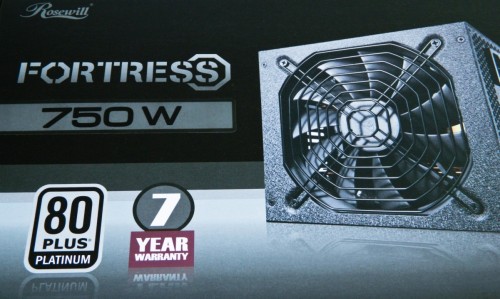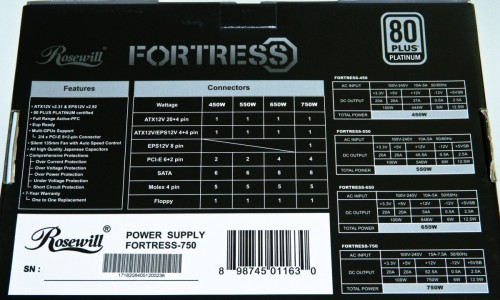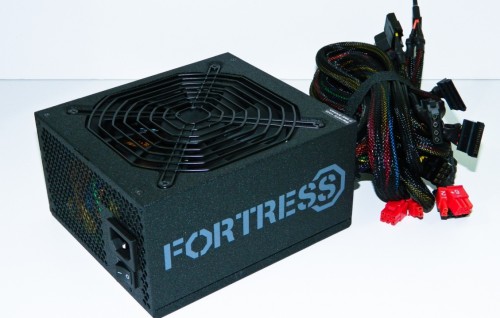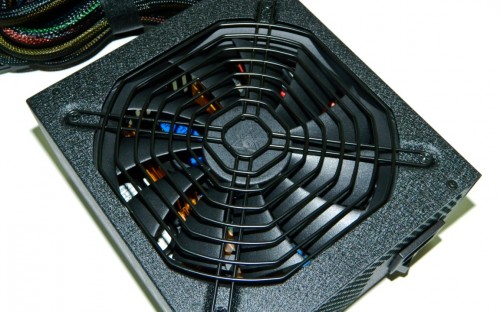It was just a few years ago that the most extreme computers sucked the life out of 1000 or even 1500 watt power supplies. While a few of those PSUs are still around, we’ve noticed a shift in the power supply paradigm the last year or so where more money is spent designing greater efficiency and implementing better components versus stretching out the wattage. Perhaps it’s due to the fact that most processors, motherboards, and video cards consume less power today. Efficiency, low power and quality components are very good features to offer consumers which means power supplies like the Rosewill Fortress 750 Platinum have a place. But first, let’s see how it performs in our review.
Features and Specifications
Let’s cover the best features quickly so you understand where the Fortress 750 fits on the PSU food chain.
- 80 PLUS PLATINUM Certified – at least 89% Efficient at full load
- All Japanese capacitors used inside
- Single 62.5 Amp 12V rail
- Four 6+2pin PCI Express connectors – SLI & CrossFire Ready
- Silent 135mm fan with Auto Fan Speed Control
- Active-PFC with auto 100-240V AC-input voltage adjustment
- Unique black textured housing
- Mesh cable sleeving with shrink wrapped ends
- Over Current/Voltage/Power Protection, Under Voltage Protection, and Short Circuit Protection – protects your system
- Continuous 750 watt operation at 50C
- Safety & EMI approved: cULus, FCC, CE, ROHS
- 7-year Warranty
Just to clarify, there is nothing wrong with PSUs with single 12 volt rails. With proper protection circuitry, the PSU will be doing more than just feeding your system much needed clean power. Also, this is the only PSU that I know of that offers a 7 year warranty.
Granted, if your unit goes out in five years, there will be a different and possibly better Rosewill unit that they will replace it with. Pricing for this unit is $179 US MSRP but sales often catch it at just $119 US.
What’s in the Box?
Your retail Fortress unit will come with the usual power cable, manual, zip ties, and screws. However, there’s two sets of black screws in the baggy.
There are four standard screws to blend with black enclosures and four thumb screws in case you want to make it go with a tool-less case. Either set should blend well with whatever your needs are. We would like to have seen some Velcro straps instead to help tidy up the unused cabling as the zip ties are semi-permanent and are one time use. Write this down Rosewill 🙂
The Heart and Soul of the Fortress
For those who take their product research seriously, the Fortress is manufactured by ATNG out of Taiwan. While their About Us page is a tad bit off center, their factories don’t have a problem producing capable power supplies among many other products. In fact, chances are you’ve used some made by them before.
Inside the power supply are two large Rubycon 400V 220uF capacitors providing the breadth of continuous wattage during operation. Interestingly, the PSU was assembled with an assortment of Nippon Chemi-Con, Teapo, Rubycon, and CapXon capacitors. The important thing is the best of them are in the proper places supporting the switching and power rails. To the consumer, that’s all that counts!
Cooling the PSU is achieved through a 135mm Globe RL4Z B1352512H fan. The closest specifications I could find says the fan tops out at 1500 RPMs and is thermally controlled. The fan should spin up just enough to keep component temps down without getting too loud. We’ve seen a similar fan designs in a the recently reviewed bequiet! Dark Power Pro PSU. It performed well so we expect this one to also measure up too.
Outside the Fortress
As you can see, for a permanent wired chassis, it looks pretty decent. The unit has a very clean durable coated housing. It’s not rough enough to remove skin but the shell can take a beating without too much noticeable wear. The cabling looks better than many other cost efficient units. The braiding is just right and the shrink wrap covers up as much of the wires towards the connectors as possible. Here is the cable and connector count.
- One 20+4-Pin Main Connectors — 22″ length
- One 4+4-Pin ATX12V/EPS12V Connectors — 22″ length
- Two 6+2-Pin PCI-E Connectors — 24″ length
- Five 4-Pin Peripheral Connectors — 34″ long
- Eight 5-Pin SATA Connectors — 24″ long
- One 4-Pin Floppy Connector
Overall, the cables are long enough to support any regular mid to full sized enclosure. As usual, some enclosures may have cut outs in odd places and may require 24-Pin and/or 4+4-Pin patch cables. Alright, let’s heat this bad boy up to 750 plus watts!






